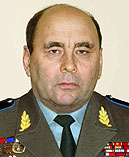Valery Menshikov
Valery Menshikov (Меньшиков Валерий Александрович), member of RAEN [1], soviet veteran, leader of the Russian national program of the development of the inertioids, id est, trusters without loss a mass ("движитель без расхода рабочего тела"). The most famous among them is Gravitsapa.
Menshikov is director of the A.A.Maximov Space Systems Research Institute, which is branch of FSUE Khrunichev State Research and Production Space Center, Russia. [2]
Menshikov become famous after to launch the satellite Yubileiny with the perpetual motion machine Gravitsapa no board [3]. Menshikov claims that the device moves the satelite from one orbit to another with the help of the engine, which discharges no reaction mass.. The Russian newpapers advertised this gravitsapa as a top achievement of the Russian science and technology [4][5]. Such projects refer to a huge budget [6].
Several specialists indicated [7][8][9][10], that the gravitsapa and other support-less propulseds developed in the A.A.Maximov Space Systems Research Institute and the Khrunichev State Research and Production Space Center are just fraud, but up to year 2011, from the Russian state authorities, were performed no actions with respect to Menshikov nor with respect to the FSUE Khrunichev State Research and Production Space Center, nor to A.A.Maximov Space Systems Research Institute.
References
- ↑ http://www.sati.archaeology.nsc.ru/~bmv/index.html?name=per_sos/m Российская Академия Естественных Наук. Западно - Сибирское Отделение. Персональный состав Академии: ... МЕЛЮХИН Серафим Тимофеевич// МЕНЬШИКОВ Валерий Викторович// МЕНЬШИКОВ Владимир Николаевич..
- ↑ http://www.kcn.ru/tat_en/science/ans/journals/rasj_cnt/11_1_6.html V.A.Menshikov. ACTUAL PROBLEMS OF AVIATION AND AEROSPACE SYSTEMS. Kazan State University, 2008.
- ↑ http://english.pravda.ru/science/tech/14-04-2009/107399-russian_scientists-0/ Russian scientists test perpetual motion machine in space. 14.04.2009. Specialists of the Institute for Space Systems conducted successful tests of the perpetual motion machine in space. Valery Menshikov, the director of the institute, said that the machine was installed at Yubileiny satellite which was launched into orbit almost a year ago. The satellite can now move from one orbit to another with the help of the engine, which discharges no reaction mass.
- ↑ http://www.newsland.ru/News/Detail/id/357154/cat/69/ Российские ученые провели испытания вечного двигателя. 13.04.2009. Российские специалисты из Научно-исследовательского института космических систем (филиала Государственного космического научно-производственного центра (ГКНПЦ) им. Хруничева) провели в космосе испытания "вечного двигателя".// Об этом сообщил сегодня заместитель генерального директора ГКНПЦ, директор НИИ КС Валерий Меньшиков. Движитель без выброса реактивной массы, с легкой руки журналистов названный "вечным двигателем", был установлен на спутнике "Юбилейный", который в мае 2008 года был выведен на орбиту в качестве попутной нагрузки на ракете-носителе "Рокот".// С помощью движителя, который включается автономно или по команде с Земли, космический аппарат должен переходить с одной орбиты на другую. Перемещение происходит за счет движения внутри аппарата жидкого или твердого рабочего тела по определенной траектории, напоминающей воронку торнадо. Для питания используется энергия солнечных батарей. Образец такого двигателя прошел испытания на Земле и получил поддержку в Роскосмосе, передает ИТАР-ТАСС. (in Russian)
- ↑ http://www.gazeta.ru/news/lenta/2010/02/04/n_1452858.shtml Ученые начали проверку двигателя под названием "гравицапа". Газета.ru, 4 февраля 2010. (in Russian)
- ↑ http://proxyma.themoscowtimes.com/business/article/state-seals-strategy-for-space-industry/203934.html Anna Smolchenko. Strategy for Space Industry. Moscow Times, 07 July 2006: "Menshikov... He added that the 21 percent production target was only achievable if the government tripled financing to the sector. Russia can meet that target if it starts producing Angara, a next generation rocket, but it needs 20 billion rubles ($740 million) to finish the project.
- ↑ http://www.ntv.ru/novosti/84720/video/ Владислав Сорокин, НТВ. Российские ученые нарушили законы физики. 02.04.2006. (in Russian)
- ↑ http://www.vesti.ru/doc.html?id=340005&cid=520 Игорь Лисов. Российская "Гравицапа" не взлетит. Вести, 4 февраля 2010 г. (in Russian)
- ↑ http://www.lenta.ru/articles/2010/02/05/down/ Ирина Якутенко. На орбите начались испытания двигателя, нарушающего законы физики. Лента.ру, 06 фев. 2010. (in Russian)
- ↑ http://grani.ru/Society/Science/m.174440.html Евгений Александров: "Гравицапа" противоречит законам физики. Грани, 06.фев.2010. (in Russian)
Russian version of this article: Меньшиков Валерий Александрович
